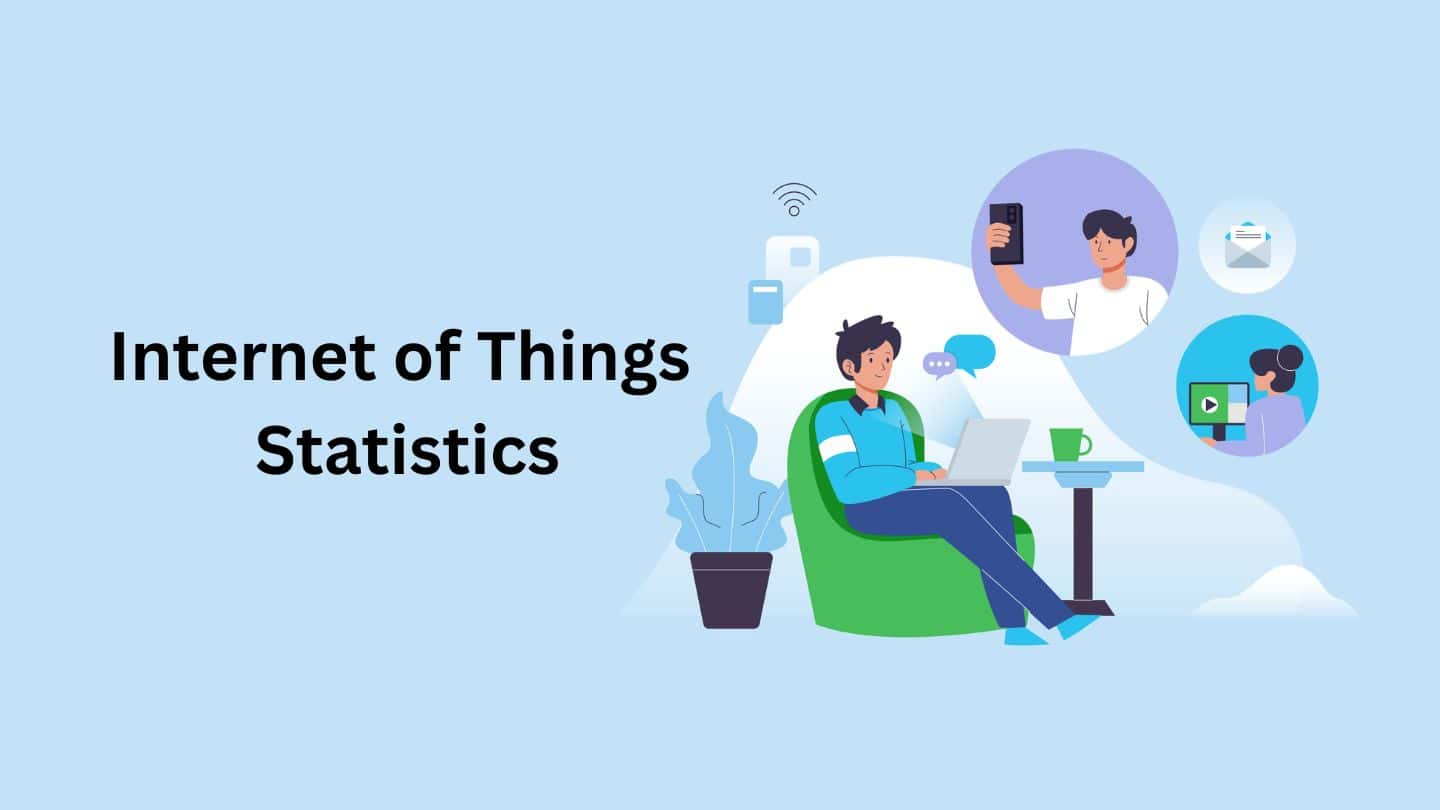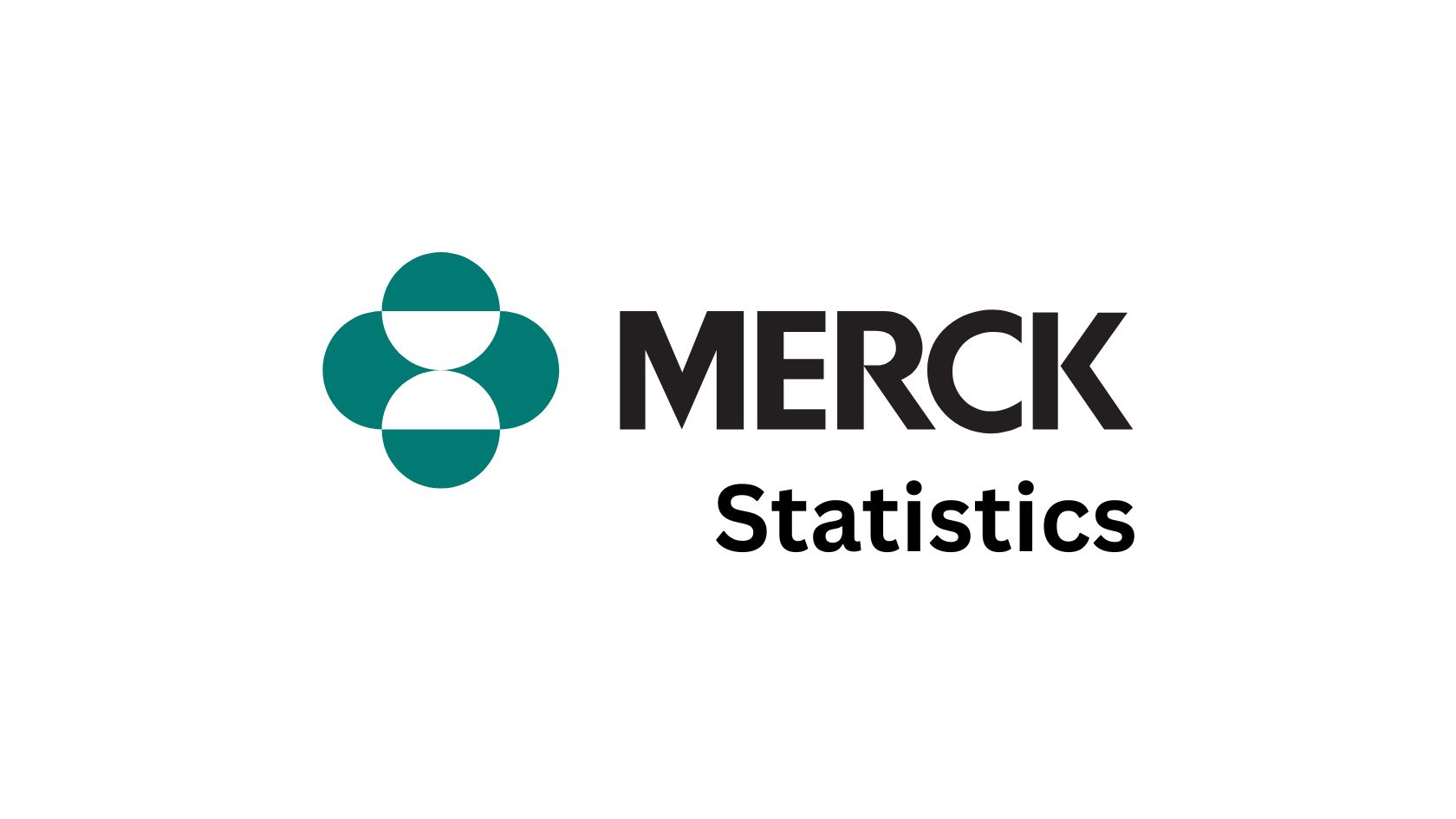Android Phones Statistics By Market Size, Users, Facts and Figures (2025)

Updated · Oct 08, 2025

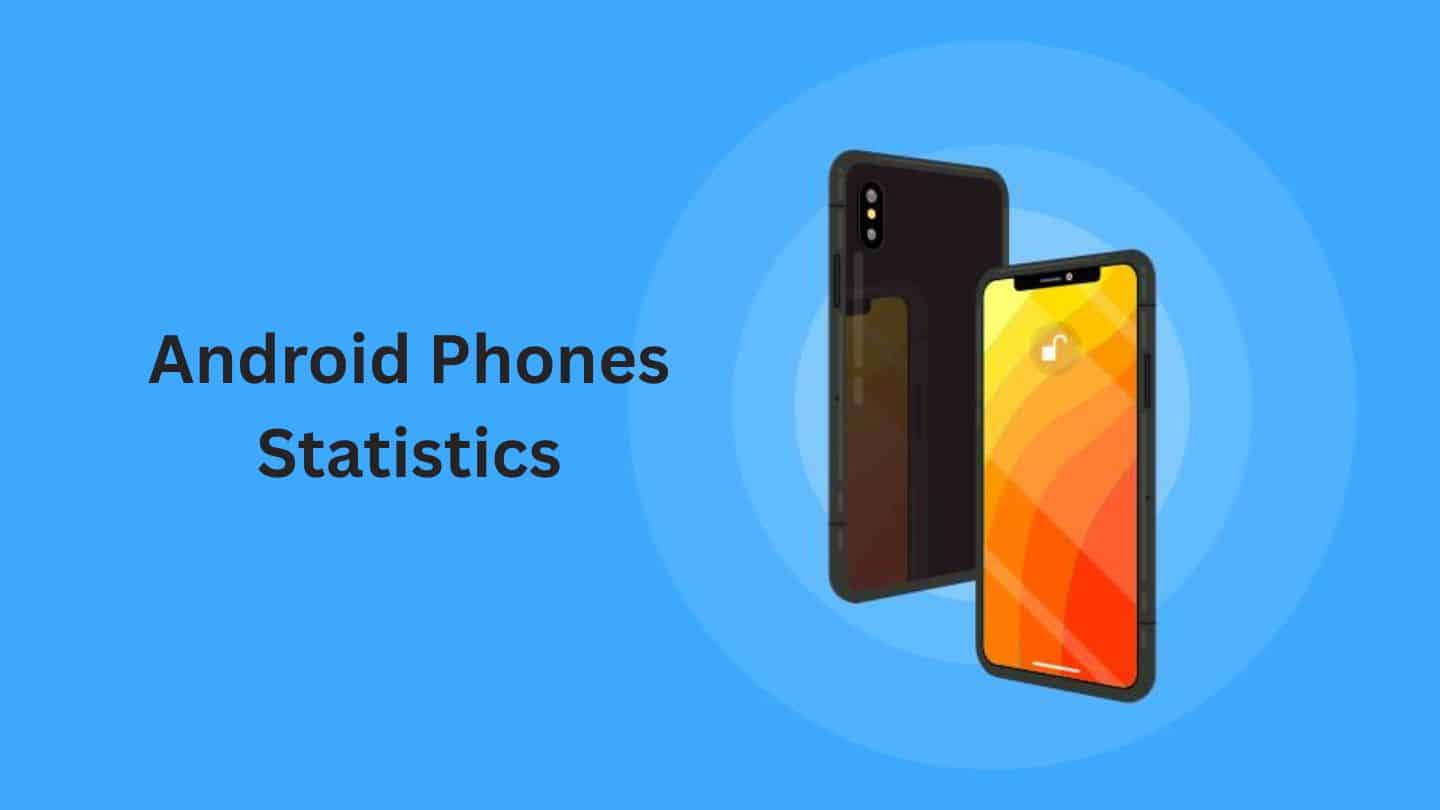
WHAT WE HAVE ON THIS PAGE
- Introduction
- Editor’s Choice
- Android Phones Market Share
- Foldable Smartphones Market Statistics
- Key Players in the Android Phone Market
- Adoption Rates of Android Phone Versions
- Demographics and Regional Variations of Android Phone Users
- Android Phone Hardware and Display Trends
- Android Phone Application Usage and Ecosystem Statistics
- Security and Environmental Impact of Android Phones
- Future Trends By 5G and Advanced Tech in Android Phones
- Conclusion
Introduction
Android phones statistics: Android has cemented its status as the dominant force in the global mobile landscape since the platform’s initial release in 2008. Far from being a single brand, the Android ecosystem represents a colossal, open-source platform driven by a large number of manufacturers, making it a powerful machine for global connectivity and development.
This article provides a comprehensive analysis of the Android phone market, meticulously detailing everything from its immense user base to the intricate hardware trends changing its future. If you need to understand the true scale and direction of Android Phones, this is the only statistical resource you will need. So, let’s get into the data.
Editor’s Choice
- The Global Smartphone Market is projected to reach approximately $876.00 billion by 2032, climbing from $510.00 billion in 2022, showcasing a robust Compound Annual Growth Rate CAGR of 70% during the forecast period from 2023 to 2032.
- The Android operating system currently commands a colossal 9% share of the global mobile OS market, solidifying its position as the preferred platform for the majority of the world’s smartphone users.
- The total active user base for Android Phones has recently surged past 6 billion individuals worldwide, illustrating the platform’s enduring, widespread demand and accessible nature.
- Samsung remains the undisputed market leader among Android phone manufacturers, capturing a dominant shipment share that places it consistently at the forefront of sales volumes.
- Despite the average global price for an Android smartphone hovering around $254, high-end flagships from top manufacturers are increasingly pushing the Average Selling Price ASP higher in developed markets.
- In the United States, which is traditionally an iOS-dominated region, nearly 42% of all smartphone users still choose an Android device for their daily mobile experience.
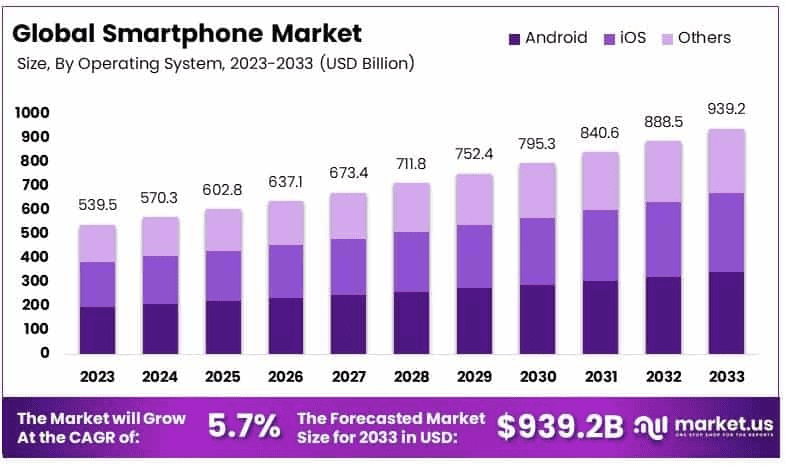
According to market.us, the entire smartphone market is still charting a significant upward trajectory, driven by consumer appetite for advanced technology and the pervasive adoption of 5G infrastructure.
Financial and Market Dominance
- The total market value for smartphones is on track for massive expansion, with projections showing a climb from $570.3 billion in 2024 to a substantial $939.2 billion by 2033.
- This strong growth forecast represents a healthy Compound Annual Growth Rate CAGR of 5.7% over the decade spanning from 2024 to 2033.
- The Android operating system maintains a commanding global lead in the market, capturing a dominant share of 63.4% of all active smartphones due to its open-source flexibility and widespread adoption by manufacturers.
- When it comes to where people buy their devices, the Original Equipment Manufacturer OEM store segment, which includes official brand stores and online channels, accounts for the largest piece of the pie at 47.6%.
Regional and Technology Adoption
- North America is a major financial hub for the market, making up a significant 42.6% of the global value, which translates to a massive USD 229.83 billion due to high spending on premium devices and established 5G networks.
- Meanwhile, the Asia Pacific APAC region, led by countries like China, India, and South Korea, is the fastest-growing market.
- The global shift to high-speed connectivity is accelerating rapidly: by the end of 2024, an estimated 45% of the world’s 5.3 billion active smartphones will be 5G-ready, which is a huge jump from the current figure of 15%.
Competitive Landscape
- Samsung kicked off 2024 with a very strong showing, reporting sales of over 60 million smartphones in Q1, driven largely by their models like the Galaxy S24 Ultra and the innovative foldable Z series.
- These top-tier Samsung flagships are heavily emphasizing Artificial Intelligence and advanced display development.
- Xiaomi demonstrated its growing competitive strength by achieving a significant 27.4% increase in shipments during Q1 2024.
| Market Value 2024 | $570.3 Billion | 2024 |
| Market Value 2033 | $939.2 Billion |
2033 Forecast |
|
Growth Rate CAGR |
5.7% | 2024 to 2033 |
| Android Market Share | 63.4% |
Latest Data |
|
Leading Sales Channel |
47.6% | Latest Data |
| North America Market Share | 42.6% $229.83 Billion |
Latest Data |
|
5G Readiness 2024 |
45% of 5.3 billion phones | 2024 Projection |
| Samsung Q1 2024 Sales | 60 Million Units |
Q1 2024 |
|
Xiaomi Shipment Increase |
27.4% YoY |
Q1 2024 |
Foldable Smartphones Market Statistics
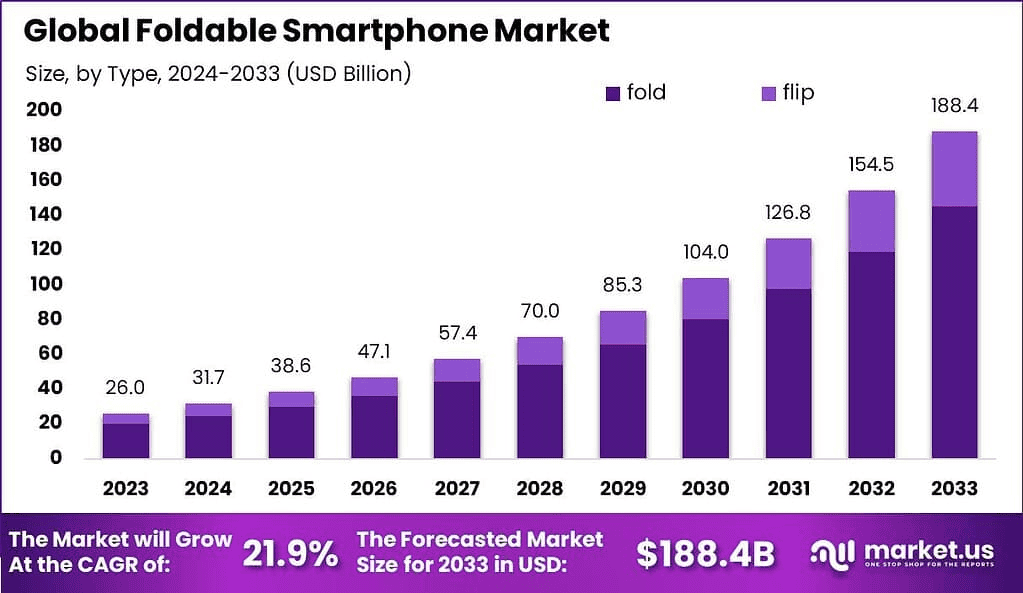
According to market.us, the foldable smartphone segment is a high-growth niche within the larger market, quickly gaining user interest and experiencing rapid technological advancement that promises a major shift in device form factors.
Financial and Shipment Dynamics
- The foldable market is projected for explosive financial growth, expected to surge from $31.7 billion in 2024 to a monumental $188.4 billion by 2033.
- This astonishing growth is reflected in an exceptionally high Compound Annual Growth Rate CAGR of 21.9% from 2024 to 2033, a rate far exceeding that of the traditional smartphone market.
- Global shipments of these novel devices reached 15.9 million units in 2023, marking a substantial 25% YoY increase that highlights the fast-paced consumer adoption.
- Experts project that this rapid adoption will only accelerate, with foldable smartphone shipments expected to increase by an even higher 38% globally in 2024.
Form Factor and Regional Preferences
- The most popular form factor for these devices is the Flip Device, which folds horizontally like a clamshell: 67% of all owned foldables fall into this category.
- The larger, book-style Foldable Devices, which open up to provide a tablet-sized screen, make up the remaining 33% of the market share
- The Inward Folding Smartphones design, where the main screen is protected when closed, held the largest segment share in 2023 at 62.1%, a preference driven by key technological developments in the hinges and displays.
- Similar to the main market, online platforms dominate sales, accounting for a 58.3% market share for the delivery of innermost folding smartphones in 2023.
- The APAC region is the engine for this market, leading the way in 2023 by capturing 45.9% of the market share and generating USD 11.9 billion in revenue.
Manufacturer and Consumer Behaviour
- Despite its rapid growth, foldable smartphones still represent a small percentage of total devices, accounting for only 1% of all smartphones held across major developed markets.
- Samsung remains the overall, massive market leader in foldable shipments, having moved over 12.5 million units in 2023, with Huawei being the second-largest player at 2.5 million units.
- In a key metric, 46% of US consumers have already stated a preference for Samsung foldable smartphones.
- Intriguingly, in Q2 2023, Huawei temporarily became the largest vendor for the larger, fold-type devices like the book-style with a 32.9% market share, though Samsung is expected to maintain its overall leadership with a massive 60.4% total foldable share.
- Consumer preference in the US is clear: 49% of consumers there prefer the smaller, vertical flip-type foldables over the larger, book-type designs.
| Foldable Market Value 2024 | $31.7 Billion | 2024 |
| Foldable Market Value 2033 | $188.4 Billion | 2033 Forecast |
| Foldable Growth Rate CAGR | 21.9% | 2024 to 2033 |
| Global Shipments | 15.9 Million Units | 2023 |
| Shipment Growth YoY | 25% Increase | 2023 vs. 2022 |
| Projected Shipment Growth | 38% Increase | 2024 Forecast |
| APAC Market Share | 45.9% $11.9 Billion | 2023 |
| Global Market Penetration | 1% of total smartphones | Latest Data |
Key Players in the Android Phone Market
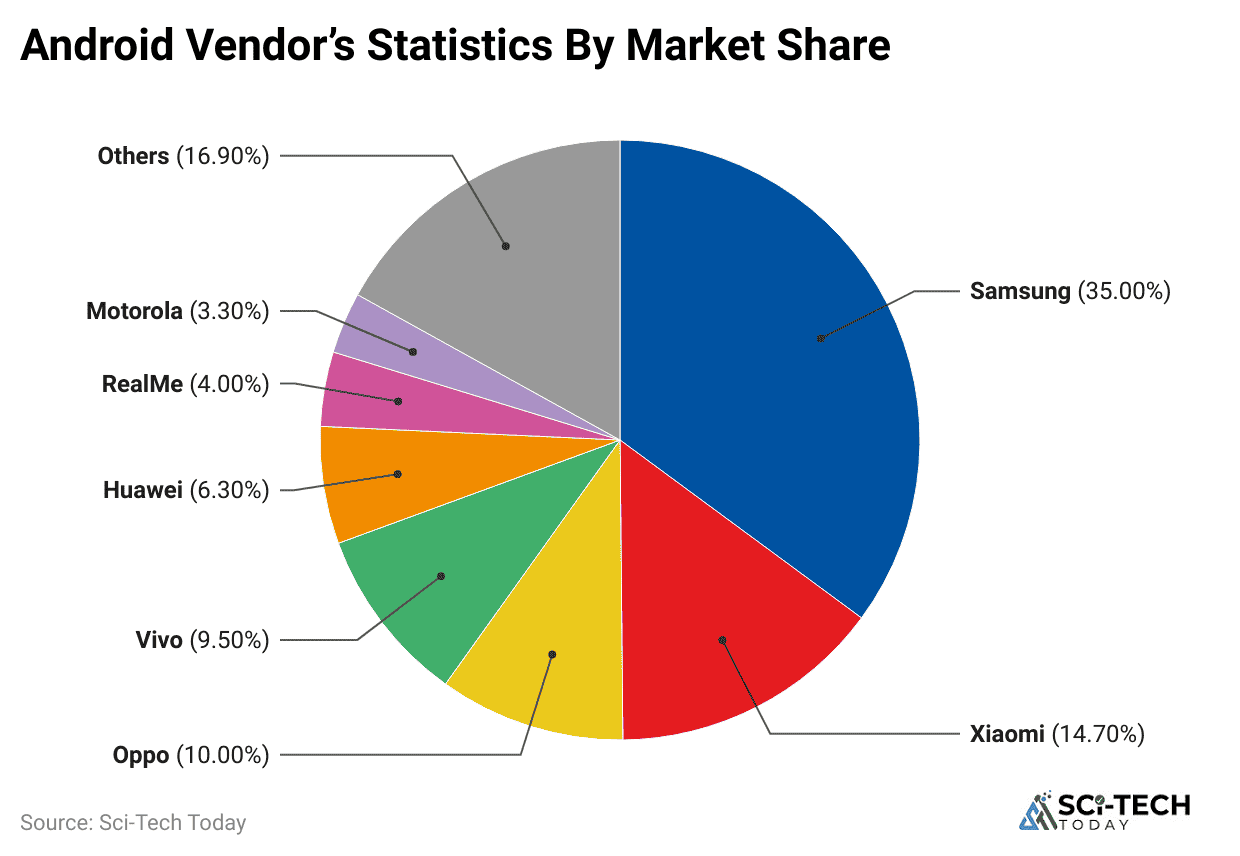
- Samsung is the perennial Android Phones market leader, frequently commanding anywhere from 20% to over 30% of the global Android shipment volume, driven by its diverse portfolio spanning from the budget Galaxy A series to the premium S and Z Fold lines.
- Xiaomi has firmly established itself as the second-largest Android phone vendor, often capturing around 15-16% of the market share by excelling with high-specification, aggressively priced devices, especially in Asian and European markets.
- The Chinese manufacturers OPPO and Vivo together represent a substantial portion of the global shipments, typically contributing a combined market share of over 20% to the total Android phone volume, demonstrating powerful regional influence.
- Newer entries and established regional powerhouses like Transsion Holdings, which owns brands like TECNO and Infinix, have shown remarkable, rapid growth in emerging markets, often achieving a top 5 global ranking in quarterly shipment reports.
- Google’s own Pixel line, while highly visible for setting the pure-Android standard, holds a relatively small market share globally but continues to grow, serving as the benchmark for software and Artificial Intelligence integration across the ecosystem.
| Samsung | 25% to 30% |
| Xiaomi | 15% to 16% |
| OPPO | 10% to 12% |
| Vivo | 9% to 11% |
Adoption Rates of Android Phone Versions
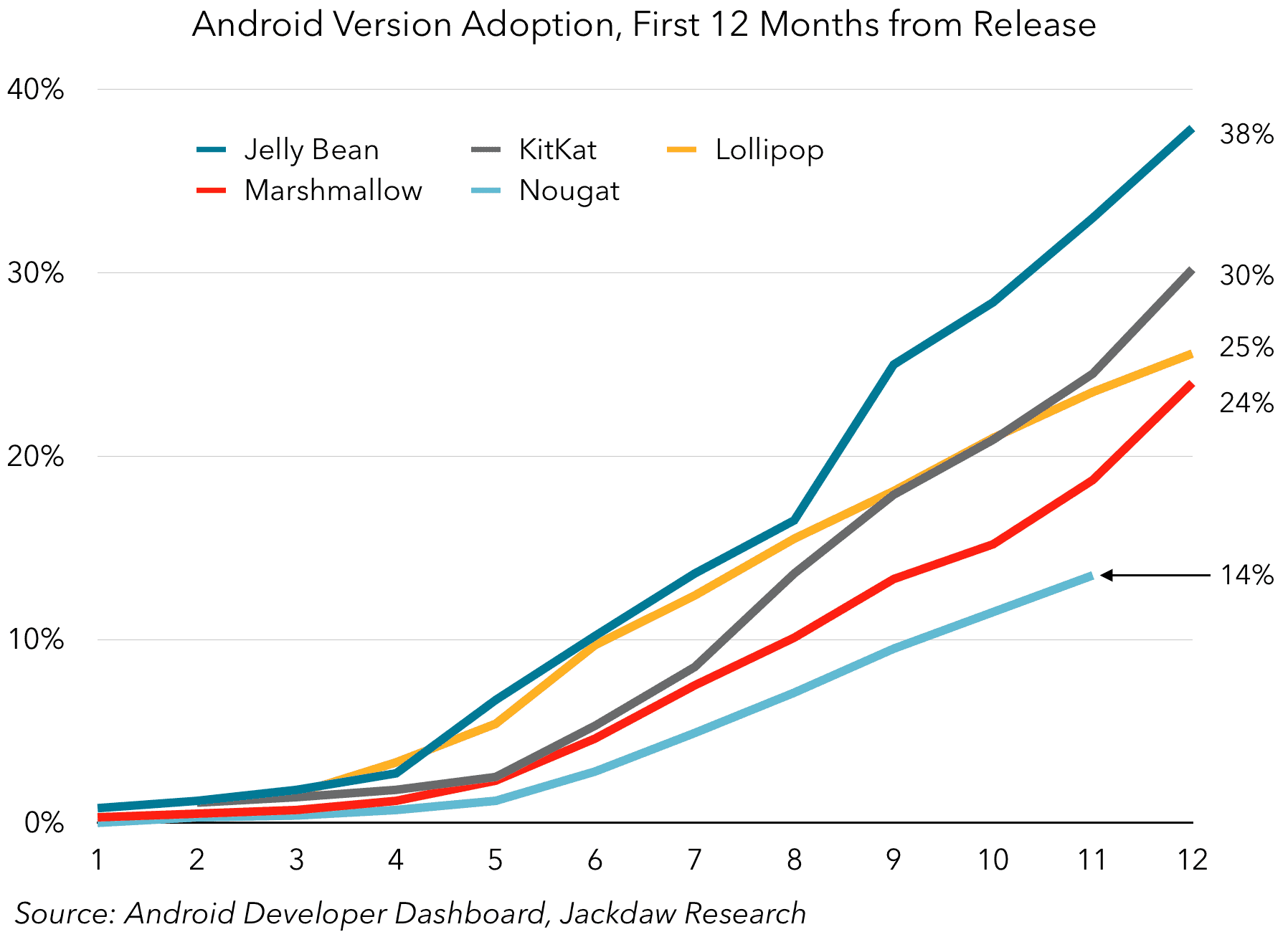
- In the most recent data cycles, newer versions like Android 13 and Android 14 have quickly climbed the ranks, with Android 13 alone capturing a notable share of over 30.33% of all active Android devices by mid-2023, showcasing faster OEM updates.
- A significant portion of the user base, however, still runs on older, highly stable versions; for example, Android 11 and Android 12 collectively maintain a substantial joint share of around 40% to 50% of the installed device base.
- The challenge of fragmentation is highlighted by the fact that even versions as old as Android 10 still account for close to 10% of active devices, posing continuous security and developer compatibility issues.
- This staggered adoption rate is directly tied to the manufacturing process, where older, cheaper Android Phones continue to be sold with older OS versions, particularly in price-sensitive markets.
- The faster uptake of the newest versions is mainly due to the flagship and premium mid-range Android Phones receiving prompt updates from manufacturers like Samsung, Google, and OnePlus within the first few months of a new OS release.
| Android 13 | 30.33% |
| Android 12 | 20.58% |
| Android 11 | 19.98% |
| Android 10 & Older | Approx. 19% |
Demographics and Regional Variations of Android Phone Users
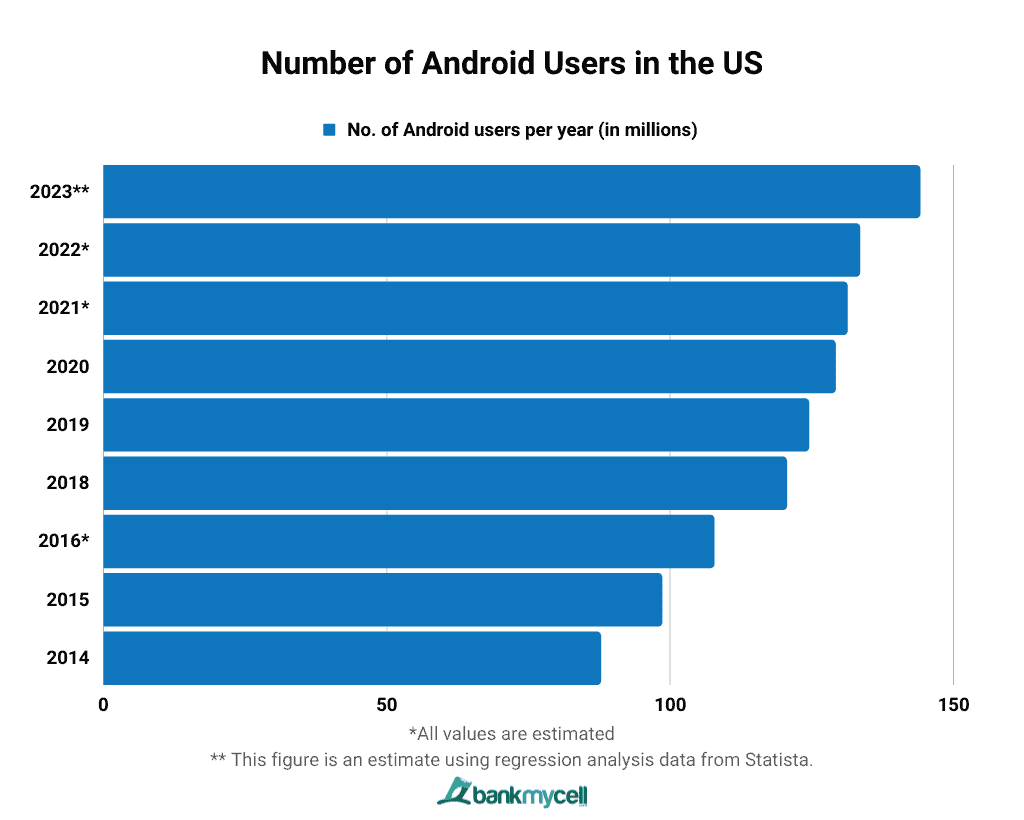
- Globally, Android Phones attract a significant skew toward a younger user base, with individuals aged 18 to 24 being the largest segment, often accounting for approximately 70% of all platform users in demographic surveys.
- The gender distribution shows a slight, but consistent, male bias, with roughly 57% of all Android users identifying as male, compared to 43% who identify as female, a pattern that holds across multiple international surveys.
- In the United States, there’s an interesting age crossover: the 45 to 54 age group shows a near-even split between iOS and Android, whereas the 55 and older demographic shows a clear preference for iPhones.
- The price accessibility of Android Phones plays a huge role in developing markets, where the platform’s market share often eclipses 85% in populous countries like India and Brazil, making it the gateway to the internet for hundreds of millions.
- In stark contrast, the US and Japan are the two largest markets where iOS consistently maintains a lead, typically capturing 55% to 60% of the user base, often correlating with higher average income brackets.
| Global | 73.9% |
| India/Brazil | 85% |
| United States | 42.51% |
| Age 18 to 24 | 70% Preference |
| Gender | 57% Male / 43% Female |
Android Phone Hardware and Display Trends

- Qualcomm remains the undisputed king of Android Phones’ processing power, with its Snapdragon chips commanding a substantial global market share of over 60% in performance benchmarking reports, leading the high-end and premium mid-range segments.
- MediaTek is a powerful challenger, holding a significant global share of around 21.5% with its focus on high-efficiency, cost-effective chipsets that dominate the high-volume, budget-to-mid-range Android smartphone categories.
- In terms of memory, the consumer expectation for multitasking has pushed the standard significantly higher: 8GB of RAM is now the largest segment, accounting for approximately 38.5% of the market, followed closely by 6GB at over 25%.
- The premium segment continues to push boundaries, with 12GB of RAM now making up a respectable 13% of the market, catering to avid gamers and power users running the most demanding applications on their Android Phones.
- The display technology is trending heavily toward fluidity: the high refresh rate of 120Hz now constitutes a massive 37.4% of the market, signalling a clear consumer demand for smoother scrolling and animation on modern Android devices.
| Mobile Processor Share | 60.1% | Qualcomm Snapdragon, focused on performance and flagships. |
| Dominant RAM Size | 38.5% | 8GB RAM, establishing itself as the new standard for the mid-range. |
| Leading Display Refresh Rate | 46.1% | 60Hz, still dominant due to the volume of budget Android Phones. |
| Premium Display Refresh Rate | 37.4% | 120Hz, highlighting the rapid adoption of high-quality, smooth displays. |
Android Phone Application Usage and Ecosystem Statistics
- The Google Play Store hosts well over 2.06 million apps, ensuring that the Android platform provides unparalleled choice and coverage across every possible user need or hobby.
- The consumption of entertainment and communication dominates app downloads, with platforms like TikTok leading the charge with an impressive 672 million downloads, demonstrating huge global interest.
- Social media giants like Instagram and Facebook maintain phenomenal download volumes, with Instagram boasting approximately 548 million downloads and Facebook at 449 million, underscoring their integral role in the Android experience.
- Mobile gaming is a colossal revenue driver, with a staggering 78% of the entire global mobile gaming community utilizing an Android device, a significant majority that drives over 2.2 billion active mobile gamers worldwide.
- Contrary to earlier stereotypes, older demographics are also heavily engaged: about 53% of individuals aged 45 to 54 actively participate in mobile gaming on their Android Phones, illustrating the platform’s broad appeal.
| Total Apps in the Play Store | 2.06 Million |
| Leading App Download Count | 672 Million |
| Mobile Gamers on Android | 78% |
| Users Who Install a Game on a New Phone | 62% |
Security and Environmental Impact of Android Phones
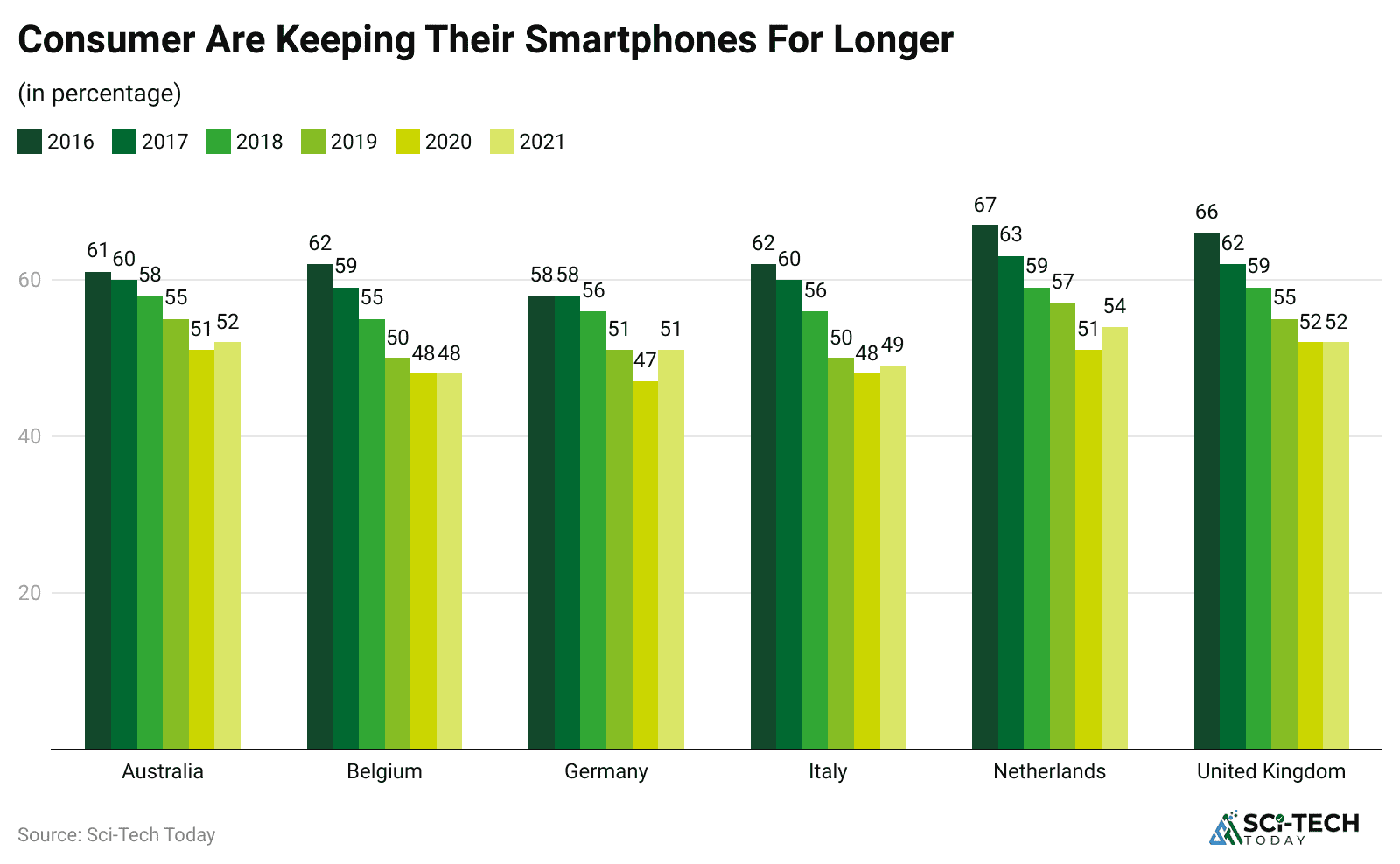
- A significant 85% of Android phone users express primary concern over understanding and configuring the privacy settings for the various Google and third-party services they use, highlighting the complexity of managing data control.
- This concern translates to high engagement with privacy-focused resources; data indicates that Android-related privacy queries consistently hold the foremost position over all other operating systems combined.
- The global installed base of Android Phones and other smartphones is expected to reach 4.5 billion by 2022, with total carbon dioxide equivalent emissions projected at approximately 146 million tons of CO2e for that year.
- A substantial 83% of these emissions come from the manufacturing and transportation of the estimated 1.4 billion new smartphones shipped annually, emphasizing the environmental impact of device turnover.
- Major Android Phone manufacturers have responded with sustainability initiatives, focusing on increasing the use of recycled materials and launching Right to Repair programs to extend device lifecycles and reduce electronic waste.
| User Privacy Concern | 85% |
| CO2e Emissions Total Smartphones, 2022 | 146 Million Tons |
| Manufacturing Share of Emissions | 83% |
| Right to Repair | Legislative Action in The U.S |
Future Trends By 5G and Advanced Tech in Android Phones
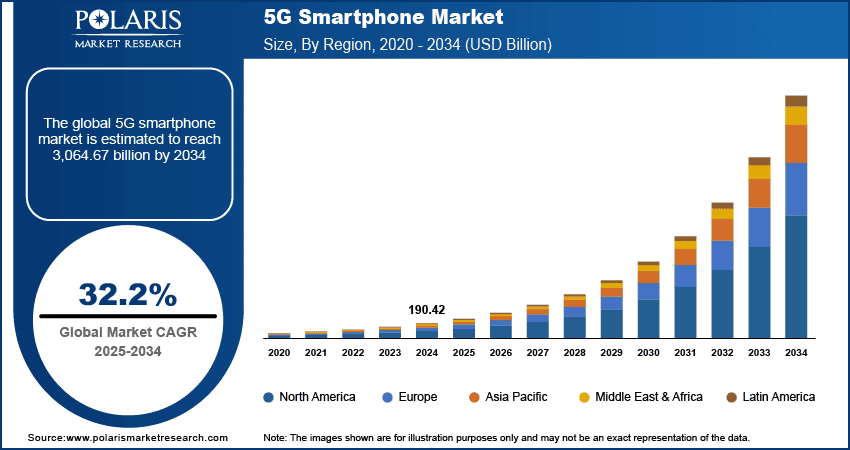
- 5G network adoption is now a dominant feature of the Android Phones landscape, with an estimated 70% of all new Android devices launched since 2023 fully supporting 5G connectivity, dramatically increasing data speeds globally.
- Countries like the United States and Japan are leading in the share of 5G-enabled connections, with 68% of their mobile connections attributed to 5G, while China leads in raw numbers with 866 million 5G mobile connections.
- The introduction of AI-powered features is no longer just a software trick; it is now driven by dedicated hardware, such as Google’s Tensor G3 chip and advanced AI engines in competitor chipsets, enhancing camera systems and on-device processing.
- The foldable display category, pioneered heavily by Android phone manufacturers like Samsung with its Galaxy Z Fold series, continues to mature and is creating a distinct, high-growth segment at the ultra-premium end of the market.
- Significant corporate funding, such as OnePlus securing $500 million in R&D, is being poured into enhancing the performance and features of Android devices, focusing on differentiating the user experience beyond mere specifications.
| New Devices with 5G | 70% of all new Android Phones |
| Leading 5G Market Connections | 866 Million |
| Foldable Phones | Led by Samsung Z Series |
| AI Integration | Driven by Dedicated Silicon |
Conclusion
Overall, from this data, we can understand, Android phones are one of the outstanding scales, fierce competition, and continuous growth. With over 3.6 billion users, a 73.9% market share, and manufacturers like Samsung driving benchmarks, Android is not just an operating system; it is the infrastructure for global mobile life.
The future of Android phones will be changed by its ability to seamlessly integrate next-generation tech like 5G, on-device AI, and advanced foldable hardware, all while addressing critical consumer concerns around data privacy and environmental sustainability. These data prove that Android is positioned to maintain its dominant global role for the foreseeable future, making it the most significant force in consumer technology today. I hope you like this content. Thanks for staying up till the end.
Sources
FAQ.
The global smartphone market is enormous and continues to grow steadily. It was valued at about $570.3 billion in 2024 and is expected to grow to nearly $939.2 billion by 2033. This translates to a consistent 5.7% growth rate each year.
Android is the clear global leader. It currently holds a dominant market share of 63.4% of all active mobile operating systems worldwide. This is largely because it’s open-source and used by many different manufacturers.
Samsung remains the biggest player in the Android market. In the first quarter of 2024 alone, Samsung reported sales of over 60 million smartphones, leading the competition with flagship devices like the Galaxy S24 Ultra.
A significant portion of devices is purchased directly from the manufacturers. The OEM store segment, meaning official brand stores and online shops, holds the largest market share for sales at 47.6%.
The shift to 5G is happening quickly. It’s projected that by the end of 2024, about 45% of all active smartphones globally will be compatible with 5G networks. This is a massive leap from the lower figures seen in previous years.
The foldable smartphone market is exploding. While it was valued at $31.7 billion in 2024, it’s forecast to grow to an incredible $188.4 billion by 2033. This massive increase represents a spectacular annual growth rate of 21.9%.
The smaller, clamshell-style Flip Devices are currently more popular. They make up about 67% of all owned foldable smartphones, preferred for their pocketable size. The larger, tablet-like Fold Devices make up the remaining 33%.
The Asia Pacific APAC region is the engine for the foldable market. In 2023, APAC captured 45.9% of the market share, showing the strongest demand and highest revenue for this new technology.
Not yet. Despite their rapid growth, foldable smartphones still only make up about 1% of the total number of smartphones currently held across key global markets. This indicates huge potential for future expansion in the coming years.

Rohan is a senior editor at Sci-Tech Today with extensive knowledge of digital marketing, SEO, and social media optimization (SMO). He is skilled at creating and editing detailed articles filled with accurate statistics that readers find valuable. As a senior editor, Rohan carefully reviews and quality-checks content from multiple writers before it is published. Additionally, he creates infographics to accompany the statistics, making the information easier to understand and more engaging for readers. Rohan's dedication ensures that Sci-Tech Today delivers high-quality and informative content to its audience.



